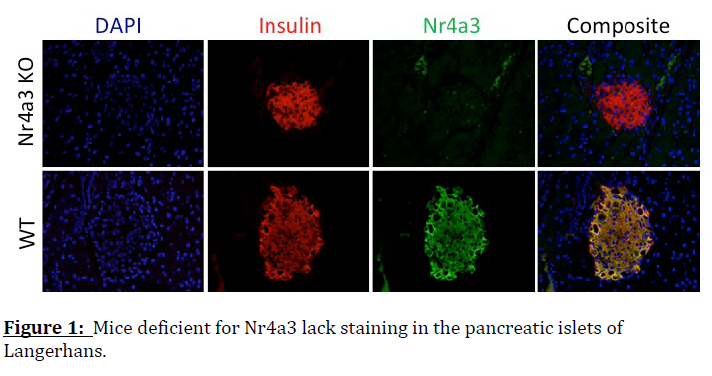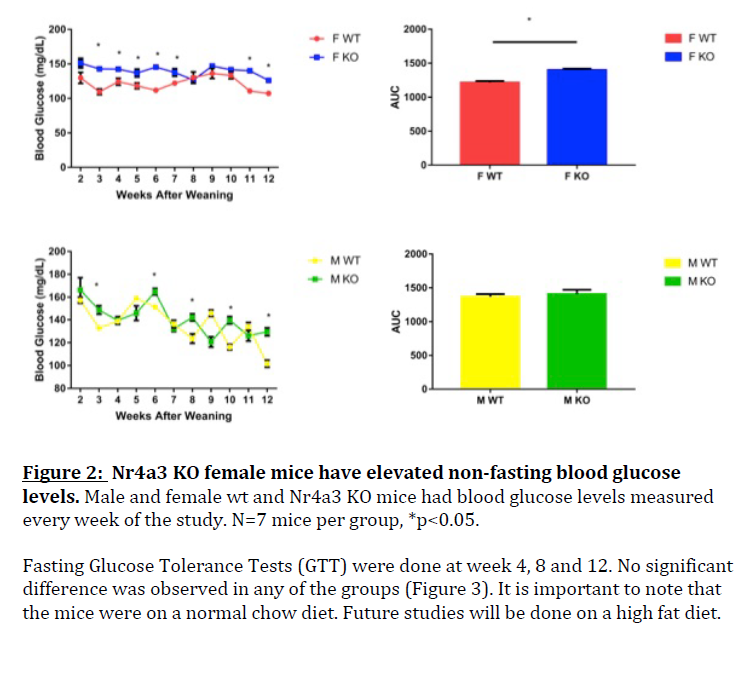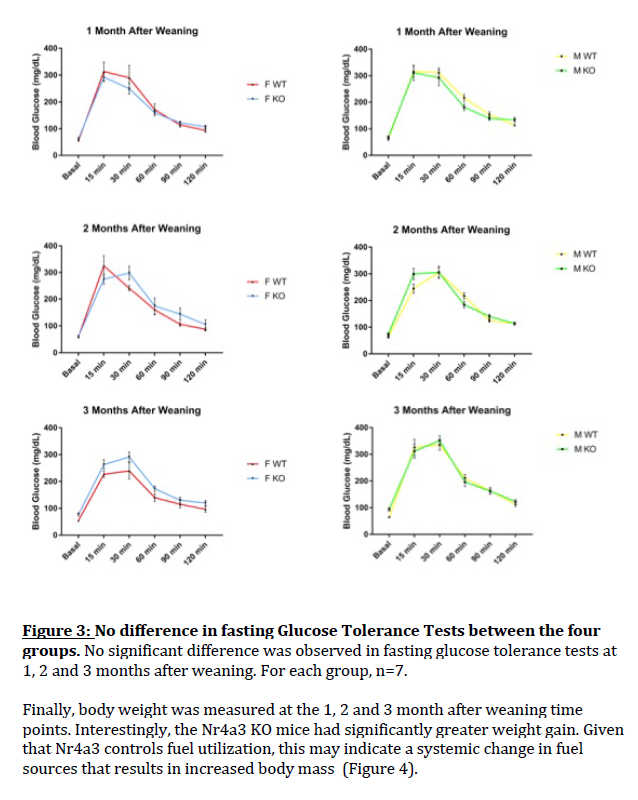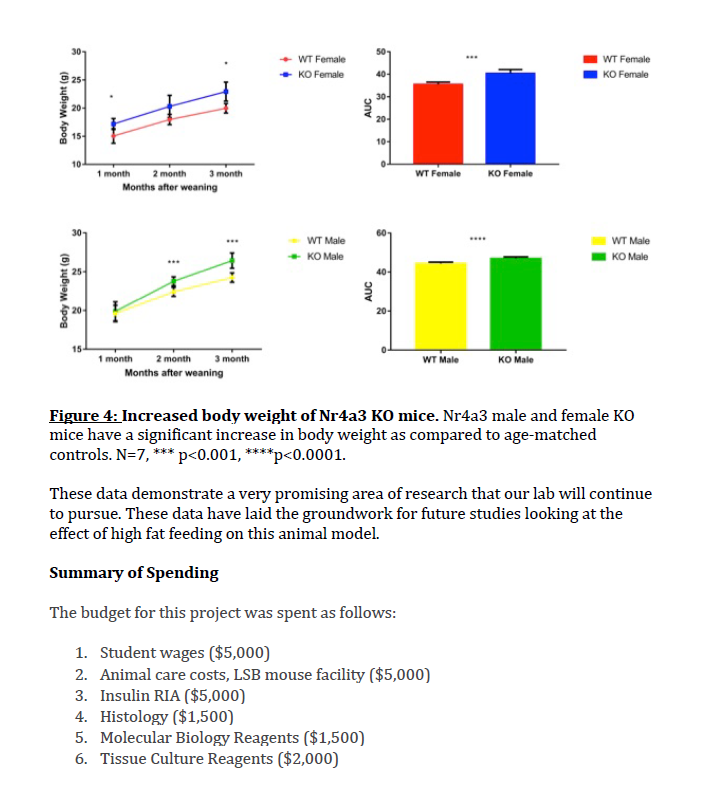Jeffery S. Tessem, Nutrition, Dietetics, and Food Science
Evaluation of academic objectives
The academic objectives of this Mentoring Environment Grant (MEG) were to 1) train undergraduate students in the scientific process to prepare them in careers as physicians and scientists, and 2) to determine if the in vitro phenotypes observed in Nr4a3 deficient beta cell lines are translatable to the Nr4a3 KO mouse. . We were successful in accomplishing these objectives, as evidenced by the training of four undergraduate students, presentation of research and local and national meetings, and initial preparation of a manuscript reporting our findings. While we did have difficulty breeding these mice, this study gives us the basis of data to begin a second round of studies.
Articles in preparation resulting from this MEG
Kener, K.B. et al. Full body loss of Nr4a3 increases body weight and enhances glucose insensibility. In preparation.
Evaluation of the mentoring environment MEG group meetings-The four trainee students and I met once a week for 30 minutes (in addition to the overall lab meeting). In this meeting the students presented data, discussed results and experimental improvements, and planned the next week’s set of experiments. In addition the students presented papers dealing with the project during each semester in our overall group meeting.
Experimental design, data acquisition and data analysis-The students were coached in experimental design, data acquisition and data analysis. The students then met with me and we went through their interpretation and design. Together we made modifications to make the science and experimental interpretation sound.
Technique mastery-Each student became proficient in a variety of techniques (animal husbandry, glucose tolerance tests, histology, RT-PCR, Western blotting, Insulin secretion assays, etc.). I trained each student in the techniques, and in addition each student had a particular technique that they mastered and improved on by training other students in the MEG group and in the lab.
Scientific writing and manuscript preparation-These students worked very closely with me for the writing of local and national abstracts, ORCA applications, other submitted papers, and the paper that is directly linked to this research. These writing session consisted of initial drafts, edits and rewriting. The students improved significantly in their scientific writing through the MEG.
Students Mentored
1. Kyle Kener-pancreatic histology and immunohistochemistry. Kyle will graduate in April 2018 with a B.S. in Nutritional Science, and is currently interviewing for medical school. Kyle is a co-author on two papers in my lab, has just re-submitted a first-author publication after addressing the reviewers concerns, and will be an author on three more publications on my lab. He presented his data at the 2016 and 2017 UCUR meetings, and the 2017 EB national meeting.
2. Sam Grover-animal breeding, glucose tolerance and insulin tolerance tests. Sam will graduate in April 2018 with a B.S. in Nutritional Science and a B.A. in Russian. Sam is currently interviewing for medical school. Sam is the coauthor on one publication from my lab, and will be an author on one more publication. He presented his data at the 2016 and 2017 UCUR meetings, and the 2017 ADA national meeting.
3. Brent Walker-insulin secretion assays and blood glucose measurements. Brent graduated in December 2016 with a B.S. in Nutritional Science. Brent is a medical student at Rocky Vista University College of Osteopathic Medicine. Brent left the lab as an author on one paper. In addition, Brent presented his data at the 2016 UCUR and at the 2016 EB.
4. Emily Barrett-RNA and protein analysis. Emily graduated in April 2017 with a B.S. in Nutritional Science. Emily is currently enrolled in a Master’s program at the University of Utah in Nutrition and Dietetics. Emily is the coauthor of one paper from my lab, and will be an author on two more papers.
Below are lists of papers published and posters presented at scientific meetings, which have resulted from mentoring in my lab since this MEG grant was awarded in 2015. BYU student authors are in bold to emphasize the number of students who have benefited from mentoring in the Tessem Lab. Publications
1. Draney C, Hobson AE, Grover SG, Jack BO, and Tessem JS. Cdk5r1 Overexpression Induces Primary beta-Cell Proliferation. Journal of diabetes research 2016: 6375804, 2016.
2. Ray JD, Kener KB, Bitner BF, Wright BJ, Ballard MS, Barrett EJ, Hill JT, Moss LG, and Tessem JS. Nkx6.1-mediated insulin secretion and beta-cell proliferation is dependent on upregulation of c-Fos. FEBS letters 590: 1791- 1803, 2016.
3. Reynolds MS, Hancock CR, Ray JD, Kener KB, Draney C, Garland K, Hardman J, Bikman BT, and Tessem JS. Beta-cell deletion of Nr4a1 and Nr4a3 nuclear receptors impedes mitochondrial respiration and insulin secretion. American journal of physiology Endocrinology and metabolism ajpendo 00022 02016, 2016.
4. Strat KM, Rowley TJ 4th, Smithson AT, Tessem JS, Hulver MW, Liu D, Davy BM, Davy KP, Neilson AP. Mechanisms by which cocoa flavanols improve metabolic syndrome and related disorders. J Nutr Biochem. 2016 Sep;35:1- 21. doi: 10.1016/j.jnutbio.2015.12.008. Epub 2016 Jan 23.
5. Banks CJ, Rodriguez NW, Gashler KR, Pandya R, Mortenson JB, Whited MD, Soderblom EJ, Thompson JW, Moseley MA, Reddi AR, Tessem JS, Torres MP, Bikman BT, Andersen JL.Acylation of Superoxide Dismutase 1 (SOD1) at K122 Governs SOD1-mediated Inhibition of Mitochondrial Respiration. Mol Cell Biol. 2017 Jul 24. pii: MCB.00354-17. doi: 10.1128/MCB.00354-17. [Epub ahead of print] PMID: 28739857
6. Sampson MJ, Lathen DR, Dallon BW, Draney C, Ray JD, Kener KB, Parker BA, Gibbs JL, Gropp JS, Tessem JS, Bikman BT β-Hydroxybutyrate improves β-cell mitochondrial function and survival. Journal of Insulin Resistance. 2017 August 31. http://dx.doi.org/10.4102/JIR.v2l1.25
7. Rowley TJ 4th, Bitner BF, Ray JD, Lathen DR, Smithson AT, Dallon BW, Plowman CJ, Bikman BT, Hansen JM, Dorenkott MR, Goodrich KM, Ye L, O’Keefe SF, Neilson AP, Tessem JS. Monomeric cocoa catechins enhance β- cell function by increasing mitochondrial respiration. J Nutr Biochem. 2017 Jul 27;49:30-41. doi: 10.1016/j.jnutbio.2017.07.015. [Epub ahead of print] PMID: 28863367
8. Kener KB, Munk DJ, Hancock CR, Tessem JS High-resolution respirometry to measure mitochondrial function of intact beta cells in the presence of natural compounds. J Vis Exp. Under Revision
Posters
1. Reynolds MS, Hancock CR, Ray JD, Kener KB, Hardman JM, Tessem JS. β-cell Deletion of Nr4a1 and Nr4a3 Nuclear Receptors Impedes Mitochondrial Respiration and Insulin Secretion. Experimental Biology 2016, April 2016, San Diego, CA.
2. Draney C, Hobson A, Tessem JS. HDAC1 increases functional β-cell mass. Experimental Biology 2016, April 2016, San Diego, CA.
3. Rowley TJ, Bitner BF, Ballard M, Smithson AT, Neilson AP, Tessem JS. Monomeric cocoa procyanidins enhance functional β-cell mass. Experimental Biology 2016, April 2016, San Diego, CA.
4. Wright B, Garland K, Tidwell C, Kang S, Tessem JS. Aged islets are refractory to Nkx6.1 mediated β-cell mass. Experimental Biology 2016, April 2016, San Diego, CA.
5. Reynolds MS, Hancock CR, Ray JD, Kener KB, Hardman JM, Tessem JS. β-cell Deletion of Nr4a1 and Nr4a3 Nuclear Receptors Impedes Mitochondrial Respiration and Insulin Secretion. American Diabetes Association 2016, June 2016, New Orleans, LA.
6. Rowley TJ, Bitner BF, Ray JD, Smithson AT, Hansen JM, Bikman BT, Neilson AP, Tessem JS. Monomeric cocoa procyanidins enhances β-cell function by increasing mitochondrial respiration. Experimental Biology 2017, April 2017, Chicago, IL
7. Sampson MJ, Lathen DR, Dallon B, Draney C, Ray JD, Kener KB, Parker B, Witt J, Gibbs J, Tessem JS, Bikman BT. Beta-hydroxybutyrate favorably alters b-cell survival and mitochondrial bioenergetics. Experimental Biology 2017, April 2017, Chicago, IL
8. Kener KB, Ray JD, Ballard M, Utsch W, Tessem JS. Determining the role of CEBP/a in functional beta cell mass. Experimental Biology 2017, April 2017, Chicago, IL
9. Parker B, Dallon D, Draney C, Sampson MJ, Witt J, Gibbs J, Tessem JS, Bikman BT. Beta-hydroxybutyrate favorably alters muscle cell survival and mitochondrial bioenergetics
10. Lathen DR, Bikman BT, Tessem JS. Palmitic Acid Mediated Nr4a Downregulation Impedes beta cell growth, survival and function. American Diabetes Association 2017, June 2017, San Diego, CA.
Description of the results/findings of the project
Aim 1: Are the phenotypes observed in Nr4a3 deficient INS-1 cells recapitulated in the Nr4a3 KO mouse?
Due to difficulty in breeding these mice, we have only recently begun acquiring data. Furthermore, until recently the only way we had to measure respiration on campus was two oroboros machines. These require over 400 islets per measurements, or the equivalent of two mice per reaction. This stopped us from measuring respiration, however given that there is now a SeaHorse on campus, this will allow us to make these measurements in the future.
We were able to validate that our mice do are, in fact deficient for Nr4a3 in the pancreatic beta cell, as demonstrated by figure 1.

Aim 2: Does Nr4a3 deletion in the presence of high fat feeding negatively affect beta cell growth function, survival and diabetes onset?
While we have made good strides in collecting data from this aim, we were unable to complete it. Our preliminary data demonstrates significant changes in the Nr4a3 KO mouse.
Male and Female Nr4a3 WT and KO mice were weaned at 3 weeks of age, and put on a normal chow diet for the following three months (12 weeks). Blood glucose was measured every week. While Nr4a3 WT and KO male mice had no significant difference in non-fasting blood glucose tests, female Nr4a3 KO mice had significantly greater non-fasting blood glucose tests, as demonstrated in Figure 2. Figure 2:



